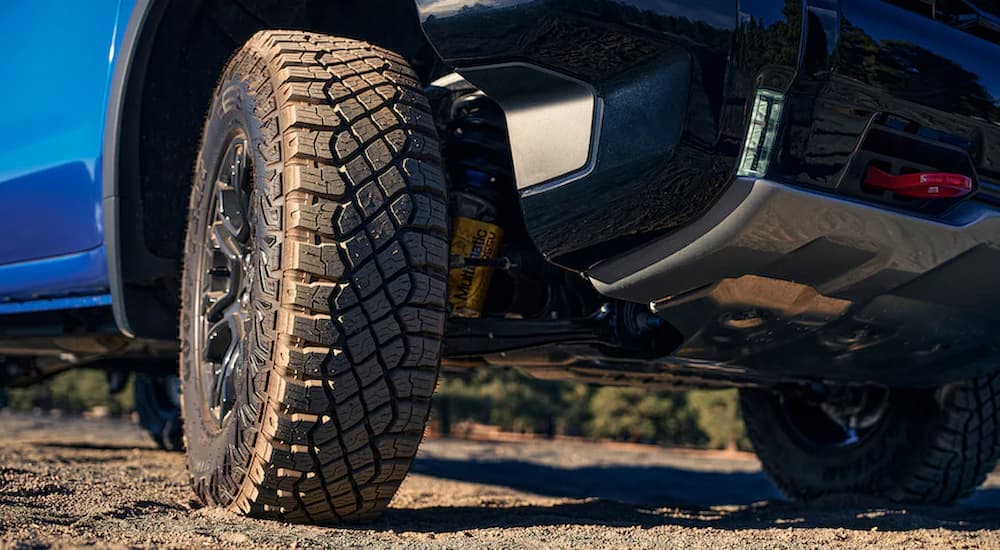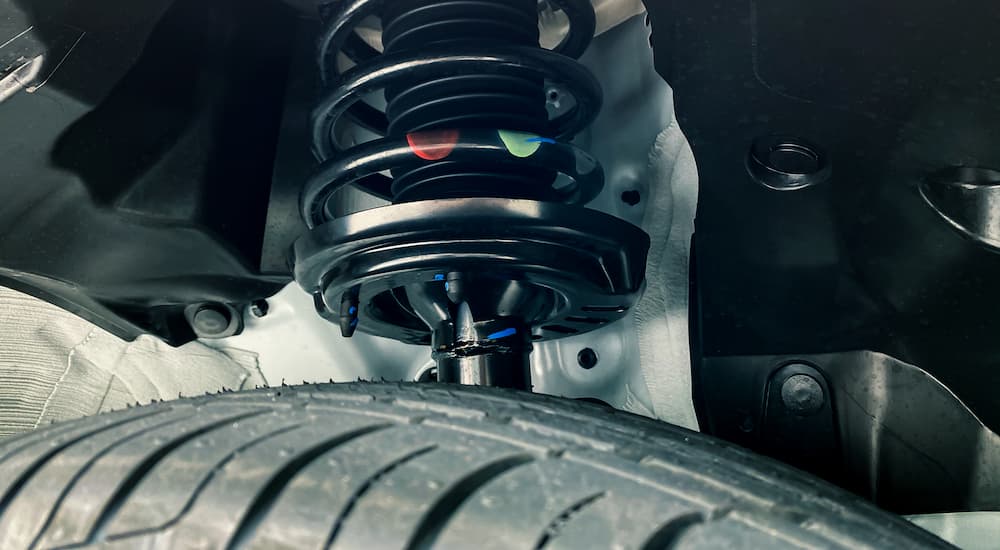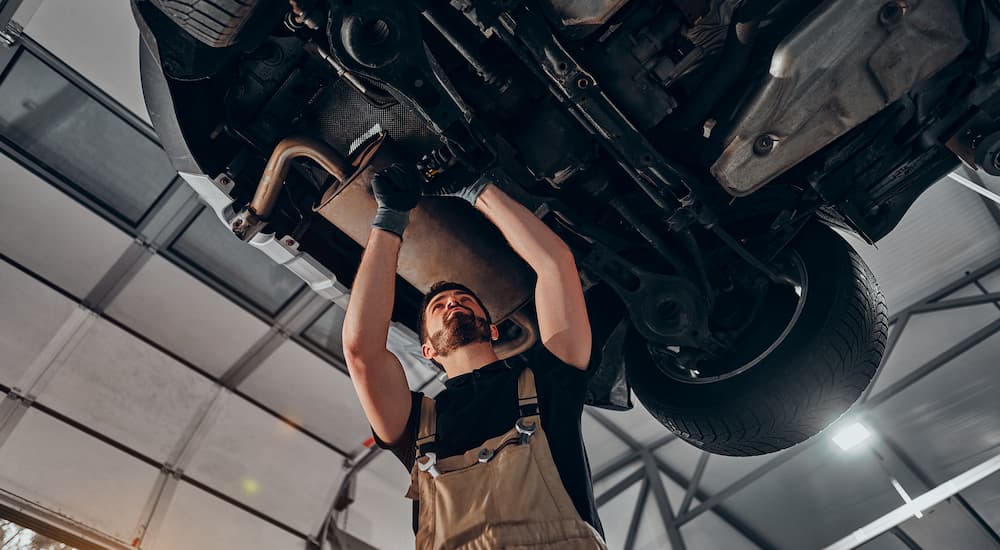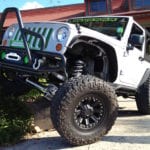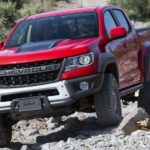For pickup drivers seeking a little more height on the road, lift kits are here to help. Lift kits are designed to improve a vehicle’s ground clearance and ride height, allowing pickup owners to transform their stock trucks into veritable off-road beasts that can easily clear almost any obstacle. While they’ve long been a popular aftermarket modification for drivers looking to customize their ride, more auto manufacturers are getting in on the game as of late, introducing new factory-installed suspension lifts that go a long way in preparing trucks for whatever challenges they might face.
Drivers are flocking to their local lifted truck dealer en masse, with brands like Chevy estimating that as many as 60 percent of the Silverado pickups sold today come with some type of factory suspension lift. The Silverado’s Trail Boss trim and new ZR2 trim (also available on the Chevy Colorado) both come standard with a factory-installed 2-inch suspension lift, giving the pickup the clearance it needs to accommodate off-road tires and take on any terrain you can imagine. Still, truck owners often debate which better fits their needs: a factory lift or an aftermarket lift.
There are certain advantages to opting for a factory-installed lift over an aftermarket kit, primarily because pickups like the Silverado ZR2 have been lifted by the same engineers who designed the truck. This ensures a safe, reliable ride and, best of all, won’t void the pickup’s limited warranty. Of course, for those who prefer the DIY approach, aftermarket lift kits present another good option.
Generally speaking, factory-installed lifts tend to be suspension lifts, which offer several advantages over their body lift kit cousins. That’s not to say that suspension lifts can’t be installed by an ambitious DIY truck enthusiast. They do require more work and mechanical know-how, or at least an expensive appointment with a qualified installer, than the relatively simple body lift kits. Let’s look at the difference between these two lift kits and give you all the information you need to decide which approach is right for you.
A Suspension Lift or a Body Lift: Which Is Right for You?
As we mentioned, the term “lift kit” encompasses two different approaches to jack up your ride: suspension and body lift kits. Both body and suspension lift kits will allow drivers to sit higher in the saddle, but they accomplish this in two different ways. These two methods also differ greatly in terms of price, difficulty, and the increase in ground clearance, so before you take on the project, it’s important to know what you’re trying to accomplish. Follow along to learn more about the differences between suspension and body lift kits, the pros and cons of each, and how much you can expect each method to cost.
Body Lift Kit
Cost: $200 to $700
Difficulty: Easy to Moderate
Increased Ground Clearance: No
Increased Lift: 2 to 5 inches
In the simplest terms, a body lift kit raises the body of the vehicle away from the frame as opposed to a suspension lift kit, which extends the vehicle’s suspension and raises every part of the vehicle up equally. This is in contrast to suspension lift kits, which increase the vehicle’s ride height and ground clearance, which is to say, the amount of space between the bottom of the vehicle and the ground. Body lift kits can give you between two to five inches of increased ride height which might not sound like much but can make all the difference in driving comfort and visibility.
A body lift kit is great for drivers looking to improve their general ride height and view of the road; however, it doesn’t provide improved ground clearance in and of itself, as it’s only the body of the truck that gets a lift. Luckily there are some workarounds available. For example, a body lift will also increase the height of the truck’s wheel wells, allowing drivers to fit larger wheels and tires on their ride. This can provide a modest bump in ground clearance, though it’s nothing compared to the kind of clearance you’ll get with a full suspension lift.
The main advantage of body lift kits comes down to their cost and relative ease of installation. Body lift kits are much cheaper, averaging $450 compared to a suspension lift kit’s $1,200 price tag, and are also much easier to install. Body lift kits don’t require any of the specialized tools, techniques, suspension, or steering adjustments needed when you’re working with suspension lift kits, making it a far simpler process that should be firmly within reach of any DIY mechanic with decent automotive knowledge. For these reasons, a body lift typically only takes about 4.5 hours, compared to a 12.5-hour average for suspension lift kits.
Drivers contemplating between body and suspension lift kits should consider how each approach will affect the pickup’s center of gravity. Changing a vehicle’s center of gravity can drastically alter its driving characteristics, resulting in more body roll when turning and decreasing overall stability. When it comes to altering a vehicle’s center of gravity, body lift kits have the least dramatic effect. A vehicle that gets a 3-inch body lift will see its center of gravity rise by 0.6 inches, as only around 20 percent of its total weight has been elevated.
Compare this to a suspension lift kit in which as much as 90 percent of a vehicle’s weight is lifted, resulting in a 3-inch increase in the vehicle’s center of gravity when installing a 3-inch suspension lift kit. Those seeking a good compromise between lift and increased center of gravity might want to explore using larger diameter tires, which will improve a vehicle’s ride height without impacting the center of gravity. For example, installing tires with a 3-inch larger diameter than your current set will improve ride height while only raising the center of gravity by 1.5 inches.
Suspension Lift Kit
Cost: $400 to $2,000 (plus installation)
Difficulty: Expert
Increased Ground Clearance: Yes
Increased Lift: 2 to 9 inches
While body lift kits might focus on improving ride height, suspension lift kits give a driver more ground clearance. These lift kits not only offer the same sort of improved ride height as body lift kits but also give drivers more space between the bottom of their vehicle and the road below. This is a particularly important attribute for any drivers looking to dive into the rough-and-tumble world of off-roading, where surmounting rocks, fallen trees, and other obstacles is all part of the fun. A suspension lift also makes room for larger, off-road tires, giving drivers the traction and control they need to safely explore the road less traveled. Most vehicles sold with a factory lift are of the suspension lift type and, more often than not, are off-road-specific models.
While body lift kits are usually limited to between 2 and 5 inches of increased ride height, a suspension lift kit can give your pickup as much as 9 to 12 inches of additional clearance. While a foot of extra height can be nice, it’s not what your vehicle was designed for, so expect to make some sacrifices in handling and safety due to the increased center of gravity. For this reason, most experts recommend limiting a suspension lift kit to a maximum of 9 inches, which gives drivers all the extra clearance they should need without jacking up the vehicle’s center of gravity to a point where it could present problems. It’s important to ease into a freshly lifted truck when opting for a suspension lift, gradually testing the vehicle’s limits until you’ve got a good handle on what that heightened center of gravity means for performance on the road.
A suspension lift might offer some real advantages over the body lift approach, but it comes at a steep cost and requires more than a little experience and mechanical confidence. As we mentioned above, a suspension lift can cost anywhere between $400 to $2,000, not counting the specialized tools you might need to invest in to get the job done. A suspension lift job can often test the limits of even the most well-stocked toolbox. It often requires the standard tools and supplies like wrenches, pry bars, penetrating oil, jacks, stands, and some less-common equipment that most at-home mechanics don’t typically own.
These are often more complex tools like spring compressors, torsion bar unloading tools, impact wrenches, and reciprocating saws. You’ll also need to be handy with a torque wrench, as the suspension lift components must be attached to the vehicle at a very specific tightness. Many drivers opt to go the professional route when it comes to suspension lift kits, but this could add anywhere from $400 to $2,500 to the total cost of the project, which could be prohibitively high for some.
So aside from price, what are some disadvantages of a suspension lift kit? Well, they’ll have a noticeable impact on your truck’s towing ability, reducing its overall capacity and, depending on the height, necessitating the installation of a drop hitch. Insurance premiums can also be higher due to the truck’s center of gravity being higher than was originally intended, and the same could go for the warranty.
It’s also important to consider the vehicle’s future when performing any major alteration, like the installation of a suspension lift kit. While your jacked-up ride might be particularly appealing to a certain subset of drivers, it’s also likely to decrease its appeal among the general population leading to a smaller pool of buyers to choose from. Of course, these drawbacks only apply to aftermarket suspension lift kits, not those installed by the factory itself.
The Key Is Knowing the Lift’s Intended Use, as Well as Your Own Mechanical Abilities
Lift kits allow drivers to transform their vehicles to fit their specific needs, but they’re not all created equal. While body lift kits offer drivers a better view and a greater feeling of command behind the wheel, they don’t drastically alter a truck’s overall functionality. Sure, they’re far more affordable than a full-on suspension lift and perfect if you’re looking to create an imposing ride with a towering stance, but they lack the attributes that make suspension lifts so popular. Suspension lifts, on the other hand, improve both ground clearance and ride height, allowing drivers to explore new terrain without having to worry about incurring any long-term damage along the way.
That said, they can cost a pretty penny if a driver chooses to take the aftermarket approach, adding hundreds, if not thousands, of dollars to a truck’s cost. This unfortunate reality makes factory-installed suspension lift kits a great alternative to the aftermarket approach, allowing drivers to get a functional amount of lift while sticking to their budget. Sure, they might not be the same type of lofty 9-inch lifts you might see on the trail, but they’re also more practical, maintaining a pickup’s driving characteristics without a noticeable toll on safety and fuel economy. No matter which route you decide, lift kits are a great way to turn your everyday driver into the pickup of your dreams.
